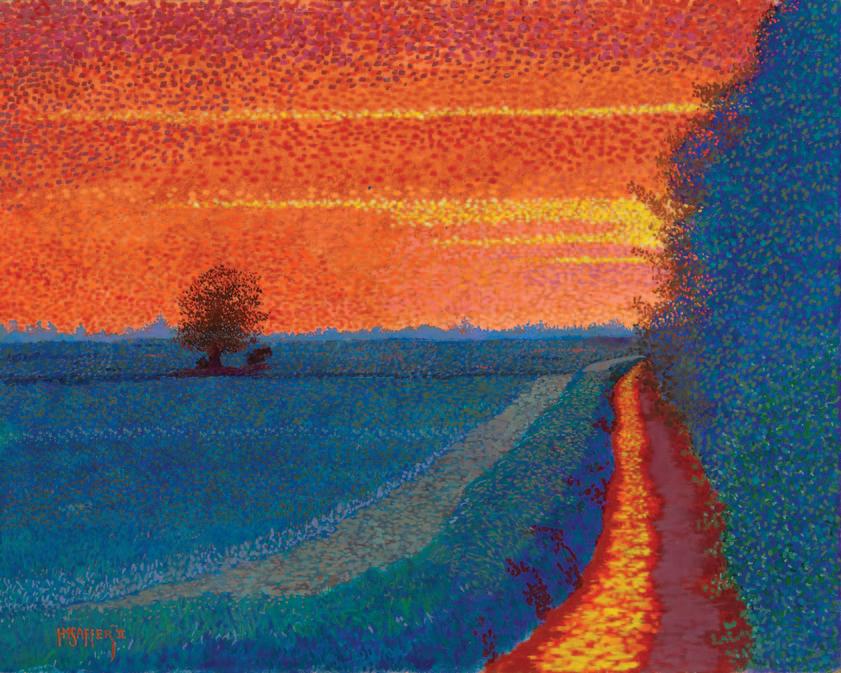
6 minute read
The Laffer Gallery
HARRY ORLYK | February 25 - March 26

Advertisement
Phone: 518-695-3181

Address: 96 Broad St, Schuylerville NY 12871
Gallery Hours: Thursday - Sunday 12pm - 5pm
FEATURING 200

Paintings
Prolific Painter, Man of Many Firsts H.M. Saffer, Artist
by Carol St.Sauveur Ferris
Credit cards, microwave ovens, the Frisbee, electric microphones, cord less phones, acrylic paint, and full-bodied electric guitars are just some of many inventions that found their way into the mainstream and into the lives of children born in the 40s. HM Saffer spent his youth through his college years during this innovative time, and no doubt his curiosity, many talents, and entrepreneurial spirit were inspired and nurtured along the way.
He was born in 1942 in Philadelphia, Pennsylvania, and was a creative, inquisitive, and confident kid. His mother was an interior decorator, and his father was a photographer, so creativity was in his DNA. Saffer’s parents encouraged his art and it showed. His early work was first shown publicly when he was just six years old, which foreshadowed his future art career. Years later, when he graduated from Temple University in 1965 with a degree in marketing and economics, Saffer headed straight to Paris, France to pursue a graduate degree in economics...and that’s where life would take an interesting turn.
Besides creating and painting throughout his youth, Saffer also played folk music and bluegrass on the banjo during his high school years. Not surprisingly, both his parents were talented musicians as well. His mother played piano, and his father was a self-taught banjo player who played with the Mummers in Philadelphia. That early musical influ ence led him to seek out and join like-minded people in Paris which was far more exciting than waiting tables. He quickly joined the ranks of professional musicians, performing with French musical tal ents like Charles Aznavour and others, and admits to having the time of his life. He was also hired by Barclay Records as a producer and had several hit records in 1968 and 1969.
Saffer shares that he was making a great deal of money at the time, so of course, he decided to go 50/50 on a restaurant with a friend who was a chef…with one requirement. He insisted on working alongside him in the kitchen to learn the culinary arts and become a chef as well. They opened two restaurants together and had a great run until the riots of ‘68 in Paris forced them to sell. Not one to let circumstances get in his way, Saffer moved to Ibiza, Spain where he promptly opened a new restaurant.
Throughout his eclectic career, painting was like a talisman, familiar and steady, as he navigated the many arts he pursued. He exhibited his paintings in all three restaurants and other locations, literally selling out his pieces and receiving great reviews from the local press. In addition, he attended L’Ecole Des Beaux Arts where some of the world’s most famous painters such as Degas, Delacroix, and Renoir attended long before him.

In 1970, Saffer returned to the United States and joined Warner Brothers Productions as both Vice-President of New Talent Acquisitions and songwriter. He landed on the charts when he co-wrote the hit song, Look What They’ve Done To My Song, Ma with Melanie. The song was covered by well-known performer Ray Charles and others. When he wasn’t composing, Saffer was painting and even painted a giant, 40-foot mural on the walls of Warner Brothers Madison Avenue office where he also exhibited his other pieces.
He later joined the Crewe Group as Senior Vice-President, working with the Four Seasons, Frankie Valli, and other well-known singers of the times, but the entrepreneurial bug bit again that very same year. Not surprisingly, Saffer established HMS Two Music Ltd., which allowed him to write and produce music for films, commercials, recordings, and Broadway productions. His musical talents were also well-represented in his work for many recognizable companies including Pepsi, Michelob, Ford Motor Company, and others.
During this time, Saffer continued painting but began to broaden his fine art focus studying Japanese brush painting which dates back to the fourteenth century. The technique is known as “Sumi-e” and translated, it means “black ink painting.” Sumi-e was introduced to Japan by Zen monks and in keeping with the simplicity and minimalism of Zen, it employs few brush strokes with gradations of black ink to convey complex meanings. Mastering both takes years of practice, and that’s exactly what Saffer did.



Alongside his burgeoning music career, Saffer’s continuing love for the culinary arts now in cluded the food of Japan which also prompted him to study their culture as well. His multiple interests motivated him to take many 3-month visits to Japan, beginning in 1983 where he studied in depth, becoming knowledgeable and proficient in each one. He also met his future wife, Hisayo. They dated for a short time then lost touch. She ended up becoming a pastry chef in Belgium but years later they reconnected in Japan and married.
It wasn’t long before Saffer approached Hisayo and said he’d like to see if he could make it as an artist. Without hesitation, she took the leap of faith and supported him in his new career. His paintings were all on paper in the Sumi-e style and were very popular in Japan. And over the years his artwork hung in several galleries including Galerie Musee and the Artbridge Gallery in Japan. Later in Hong Kong, he became the res ident artist at Kwai Fung Him Gallery and enjoyed numerous suc cessful solo exhibits. Unfortunately, in 1994 when the economic bubble burst in Japan both galleries failed, and he lost all his valuable paintings. He and Hisayo had two children by then, so they decided it was time to move the family to the United States. They settled in upstate New York where they still live.
Saffer soon discovered that Americans prefer oil on canvas rather than ink on paper which he had been doing exclusively in Japan. Contemplating what he would paint next, he discovered the landscapes of Gustav Klimt at the Clarke Art Institute at Williams College, in Williamstown, MA. He was surprised and taken by these beautiful pieces which aren’t nearly as well-known as his erotic paintings of women. Klimt’s style was similar to Pointillism, but the differences are what set his work apart from those who preceded him and what inspired Saffer.
Pointillism is a unique painting technique that became popular in the mid-nineteenth century. It followed Impressionist art which was defined by thick brushstrokes of paint capturing the essence of a subject rather than the details. In contrast, the artist using the Pointillism technique applies precise small dots of saturated color in assorted sizes close to gether, creating shapes, shadows, and light. The composition then comes together as the viewer steps back from the piece and views it as a whole.
Klimt employed the fundamentals of Pointillism but used large and small dots, dashes, and slashes to create his landscapes instead of all small dots. He also used vibrant colors. Inspired by what he saw, Saffer painted a couple of pieces trying Klimt’s more boisterous technique. They were instantly well-received, soon hung in a gallery in Connecticut, and sold quickly. Over 25 years later his paintings still hang in that very gallery and do quite well.
Saffer is now widely known for his Pointillism landscapes which are painted with a nod to Klimt. He is a self-described prolific painter, painting twelve hours a day, every day for nine months of the year, leaving the summers for commission work and biochar gardening. He admits that when he gets an idea, takes a good photograph, or someone sends him a picture, he has to drop everything and paint it. And when he paints, Saffer does a series of four paintings that start small and get larger with each new canvas. His largest paintings to date are 44” x 44” square. Incredibly, Saffer always has six or seven paintings going at one time because he simply cannot wait for them to dry, so he moves on to another one in the meantime.

A few examples of Saffer’s beautiful landscapes include:
Harvest Fields featuring undulating fields painted in vivid yellows and oranges with a vibrant green landscape and a blue, cloud-filled sky.

Moonglow painted with a moody blue sky and water accented by the glow of the moon.
And Shadows 1 featuring an intricate pattern of shadows cast by rows of brightly illuminated tree trunks on a bright yellow ground.
Given his distinctly different, yet connected careers in the arts, he was asked what might his next chapter be? His answer? A writer. But in order to be a successful writer Saffer knows he’d have to give up some painting time to devote to writing. He doesn’t want to do that. So, painting it is.
Now at the tender age of 80, Saffer is still going strong and exceedingly grateful for his amazing life. “I’ve had an incredible life. I say to myself if God forbid, I passed away today, I’d have no regrets. I’ve done so much. Traveled so much. There’s nothing I'd do over. I’ve had a great life.”

And that he has.
To view and purchase Saffer’s work, visit his website at www.hmsaffer.com or visit one of the many galleries representing his work listed there as well.



























